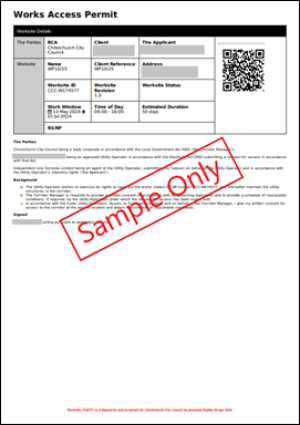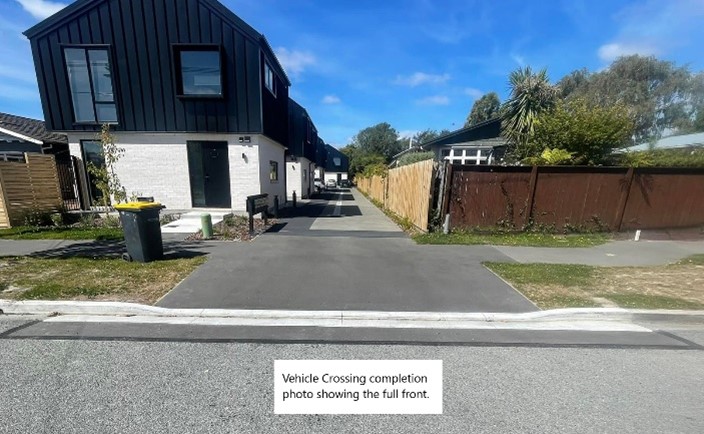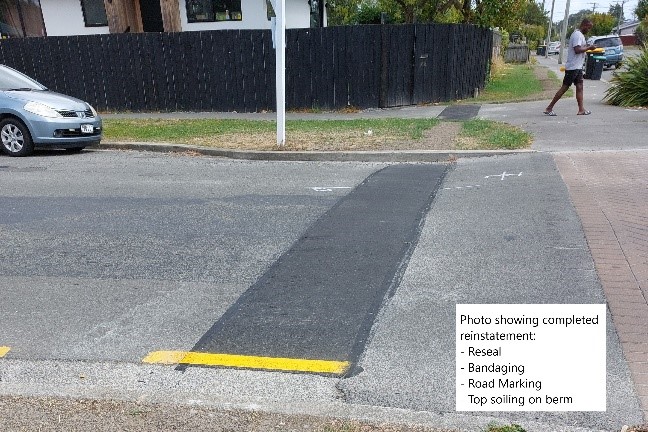Christchurch City Council is responsible for approving and coordinating works within the legal road corridor and ensures that these works comply with the requirements of the relevant codes, bylaws, acts and standards.
If you're planning to carry out any work or activity that affects the normal operation of the road, footpath, or berm, you must submit a CAR application before you start. This ensures that all work is done safely and complies with relevant regulations. In addition, a CAR is required for the following reasons:
- To secure a Work Access Permit (WAP) which is a formal confirmation of acceptance to work in the legal road/corridor. Conditions of this access is attached to the WAP.
- To coordinate your works with other parties as required.
- To confirm that all required documentation is obtained before work commences e.g. approved design, resource or building consent.
- To ensure that existing assets and amenities are considered, e.g. surfacing, structures, underground utilities, road landscape and trees.
- To ensure that road assets are reinstated as per required standards and maintained during the warranty period (defects liability).
A CAR is required if you are (but not limited to):
Utility operators and their contractors
- Digging, trenching, drilling, and any other types of excavations to install or maintain utility assets.
- Placing any pipe, duct, pole, cabinet, manhole, or other structure below, on or above the road corridor.
- Accessing and working on manholes, kiosks, cabinets etc.
- Any non-excavation works e.g. water leak repairs, cable hauling, overhead line works.
- Road upgrade, resurfacing, and any other road maintenance activities.
- Trees and Road landscape maintenance works.
Others
- Vehicle Crossing construction(external link) - Design pre-approval required.
- Temporary use of legal road(external link) – Placement of containers, skip, scaffolding, use of restricted parking etc.
- Structures on the road(external link) e.g. bollards, verandas, retaining walls (Council permission required).
- Temporary Site Access – For site deliveries, private construction, concrete pour, demolition, and any other activities that may encroach the road corridor.
- Installing private utility connections – e.g. water, wastewater, drainage etc.
- Events that may affect the road.
- Any other activity that will alter, or cause to be altered, the surface and the normal operations of the Road corridor.
Before you apply for a CAR, the following requirements must be secured and submitted with the application.
- Description of work – Describe the scope of work and methodology.
- Supporting documents
-
- Site or lay plan/diagram – This must be approved by the relevant party (e.g. utility operator, building consent etc.) and show the full extent of the work/activity.
-
- Dilapidation/Pre-start photos – Must show the current condition of the road asset and must include any trees street furniture and any other above-ground structures along or near the work area.
- Approved Traffic Management Plan (TMP) - This can be done as part of the worksite request through myworksites.co.nz(external link)
- Tree Protection Management Plan (TPMP) – If working within the vicinity of Street Trees as per 0 Working around trees of the Council’s Tree Policy(external link).
-
The following information must be supplied with the CAR application
- Name, and contact information of the: applicant, principal client, and bill payer.
- Address.
- Type of work (excavation or non-excavation).
- Work window dates.
- Excavation dimensions.
- Purchase order number.
Underground service plans
The applicant lodging the CAR is responsible for ensuring that other utility operators that may be affected by the works are consulted and/or notified. If you are excavating, you must obtain underground service plans for your proposed worksite before groundbreaking. Some underground service plans can be found by visiting beforeUdig.co.nz(external link)
Please note that not all utilities have opted to use this service therefore you will need to contact them directly.
All Christchurch City Council CAR applications are processed through myworksites.co.nz(external link)
- Create an account on MyWorksites.
- Create a project and submit your worksite application and upload the required information.
- Your request will be confirmed via email, and you will be given a unique worksite number.
- Within the prescribed timeframe, the assigned corridor manager will process your application or inform you if more information is needed.
- You will receive an email that your worksite is approved, subject to reasonable conditions.
Timeframes
The CAR must be submitted within the following minimum period before the utility operator intends to start the work, unless otherwise agreed:
- Five working days for minor works.
- Fifteen working days for major works and project works in roads.
Help with the online application process
- Use the information and training videos on our MyWorksites information page(external link).
- Support and FAQs can also be found on MyWorksites site(external link).
- For more information about TMPs, please visit our traffic news and information page(external link).

Sample Works Access Permit
Approval
Submitting an application is not an authority to start work unless it is an emergency. You must wait until you receive your approved Work Access Permit (WAP) by email.
Applications must be made at least 5 working days for minor works and 15 working days for major and project works before planned start.
Cost
The Fees - Streets and Transport(external link) are set out within the Christchurch City Councils Fees and Charges.
These fees are separate from any fees incurred by 3rd party service providers to complete Traffic Management Plans or other work.
Payment
You will be advised of the fee during the application process and be sent an invoice for payment.
You must provide the correct bill payer information and Purchase Order number as part of your application, otherwise, your application will not be processed.
Start work
Once your application is accepted and you have a copy of your Works Access Permit (WAP), you may access the legal road within the Work Window Dates approved. At least two working days before commencement of work, you must notify the Road Corridor Manager by changing the status of your site to 'Work Started' on your Myworksites page.
Work in progress
A copy of the Works Access Permit (WAP) must be kept on-site at all times. Within the duration of the works, you must make the site available for inspection by any person representing the Road Corridor Manager.
Work completion
After completing the work and you made appropriate reinstatement, you must submit a Work Completion Notice (WCN) within 10 days of your work end date through MyWorksites.
You must submit the following with your A9 form - Work Completion Notice [DOCX, 19 KB]:
- Filled out A9 Form – Include the following attachments:
- Amendments to information provided on the CAR e.g. plan, specifications etc.
- A copy of the compaction tests.
- A written statement confirming that the completed Works comply with the WAP conditions.
- A sketch or plan showing the extent and location of the Work carried out (as built).
- Details of any outstanding works e.g. Road Marking, texturizing etc.
- After photos – must show the full extent of the reinstatement.
Your completion notice will be reviewed within 15 working days. The Corridor Manager may require more information and conduct an inspection to confirm that work is up to the required standards.
Warranty period
If the worksite involves any type of excavation, the accepted Work Completion Notice will be placed on a two-year warranty. Any failures to the reinstatement within this period will be your liability.
Completion of Maintenance Notice
After the two-year warranty, you must submit a filled-out A10 - Completion of Maintenance Notice Form [DOCX, 19 KB] through MyWorksites. Once accepted, your worksite will now be fully handed over to the Council and your liability to the site ends.
National Code of Practice for Utility Operators' Access to Transport Corridors
This Code of Practice(external link) defines the set of standards for working on the road and the Corridor Access Request (CAR) process.
The code is a legislated requirement under the Utilities Access Act 2010(external link) and provides a nationally consistent and cooperative framework for corridor managers and utility operators, to manage transport corridors while also providing for the access rights of utility operators.
Training
New Zealand Utilities Advisory Group (NZUAG) (external link)offers a new online training module for those who work in transport corridors to explain the essential elements of safety.
This is offered free to all participants for the first six months following its launch on Monday 28 August 2023.
The course teaches workers about the code and how to ensure everyone works in a safe and managed way. It was designed by the team at Open Polytechnic | Te Pūkenga and takes about 45 minutes to complete.
Students are expected to get at least 80% of the questions correct to pass.
Sign up for the code training course. (external link)
Construction Standard Specification | Infrastructure Design Standard
These specifications (CSS)(external link) set out the Christchurch City Council technical requirements for the construction of land and asset developments undertaken both on behalf of Christchurch City Council or that are intended to be taken over or maintained by Christchurch City Council.
The Infrastructure Design Standard (external link)set out the technical requirements for the design of land and asset developments. As such, there is a degree of interrelatedness between these two documents, and they should be read in conjunction with each other.
Traffic and Parking Bylaw 2017
The Traffic and Parking Bylaw 2017 (external link) sets out the requirements for parking and control of vehicular or other traffic on any road or area under the care, control or management of the Council.
Part 3: Interference with Road, Traffic or Pedestrians of the Bylaw covers unauthorised activities that may affect the normal operating conditions of a road.
These activities may include:
- Events affecting the road - An event includes major public events (such as the Christchurch Marathon and the Santa Parade), as well as community events (including street parties).
- Temporary use of legal road - Examples of temporary acts include operating construction equipment or machinery from the road, placing a shipping container/skip on the road; erecting temporary fencing or scaffolding on the road; and temporary art installations. Road within this context includes the footpath, berm, verge, carriageway, etc.
- Vehicle crossings - No person may construct or alter any vehicle crossing across a footpath or a road unless the person has the prior written permission of an authorised officer.
- Temporary access ways - No person may construct or use a temporary access way across a footpath or a road unless the person has the prior written permission of an authorised officer.
All works within the Christchurch City Council’s legal road are subject to the standards and provisions of the following:
- Local Government Act 1974 and 2002.
- Christchurch City Council Traffic and Parking Bylaw 2017.
- National Code of Practice for Utility Operators’ Access to Transport Corridors (NCoP).
- Christchurch City Council Construction Standard Specifications (CSS).
- Christchurch City Council Infrastructure Design Standards (IDS).






